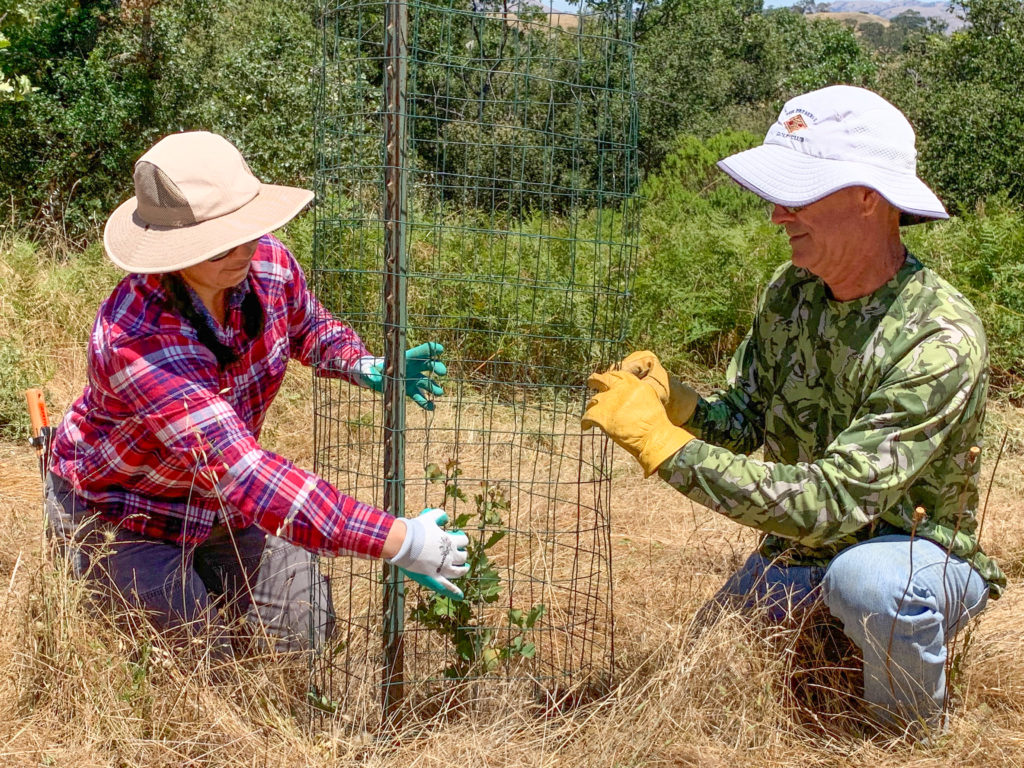There is a lot to explore on The Preserve’s 20,000 acres. A stroll in the Openlands with a neighbor or a member of the Conservancy team can reveal exciting discoveries and inspire new passions. Originating as a joint effort to manage invasive thistles, one landowner partnership has evolved into protecting rare deciduous oaks. When landowners team up for conservation, exciting things can happen.
Ricky Koffey and Barbara Thrasher partnered with their neighbors Cary and Cindy Whitfield to collaboratively manage their Openlands for invasive weeds. Their relationship has a long history, Cindy and Barbara are both from Bethesda, Maryland and are longtime family friends. Managing their adjacent properties was an easy fit and consistent with their mutual interest in conservation. For Rick, caring for their land is an opportunity to contribute to the conservation goals that this community is built on; it was this opportunity that drew the Koffey-Thrashers to The Preserve in the first place. To neighbors, he recommends, “taking a careful walk through your Openlands to see what is there.” Which is exactly what Rick did just a year ago with his neighbor Cary, and the Conservancy’s Executive Director Christy Fischer.
When the two families reached out to the Conservancy to walk their Openlands, the goals were to manage invasive weeds and plant oaks to replace older senescing trees along their shared driveway. During the site visit however, they discovered unusual native bunch grasses and several valley oak seedlings in their meadows. The discovery of valley oak seedlings was intriguing, as natural recruitment of this species has become rare throughout the state.
 Valley oaks (Quercus lobata) are native to California and notable for their thick, alligator skin bark. This long-lived species can persist for over 200 years and can grow up to 100 feet tall. The magnificent trees are deciduous, losing their lobed leaves in the fall, and can occur in a savanna or woodland landscape, like the Enchanted Forest. Once extensive, valley oaks are now rare throughout California with a decrease in their natural recruitment due to increased competition with other species for limited resources and a decline in acorn production. On top of those odds, seedlings have to contend with herbivores munching on their fresh sprouts. Currently, less than ten percent of seedlings ever reach sexual maturity. Often times simple solutions are the most effective. By simply caging young trees we can foster their growth, survival and success.
Valley oaks (Quercus lobata) are native to California and notable for their thick, alligator skin bark. This long-lived species can persist for over 200 years and can grow up to 100 feet tall. The magnificent trees are deciduous, losing their lobed leaves in the fall, and can occur in a savanna or woodland landscape, like the Enchanted Forest. Once extensive, valley oaks are now rare throughout California with a decrease in their natural recruitment due to increased competition with other species for limited resources and a decline in acorn production. On top of those odds, seedlings have to contend with herbivores munching on their fresh sprouts. Currently, less than ten percent of seedlings ever reach sexual maturity. Often times simple solutions are the most effective. By simply caging young trees we can foster their growth, survival and success.
Rick and Cary became enthusiastic about protecting their valley oaks and began caging them after discovering the trees a year ago. Following up this year, the Conservancy and the landowners discovered even more seedlings, including a few coast live oaks. In total, 26 seedlings have been caged. Moreover, other members of the community are also observing valley oak recruitment throughout other parts of The Preserve! Six valley oak seedlings were caged at Andrew and April Bosworth’s on Black Mountain Trail prior to construction and Nick and Jane Wyer have caged a number of trees in the Enchanted Forest. Longtime Preserve arborist, Marueen Hamb, explained that we are experiencing a once in 200 years set of circumstances that allow these baby trees to emerge.
We encourage you to nurture your valley oaks and hope you reach out to us or your arborist for guidance and help. Caging the trees helps reduce grazing by foraging species and unintended loss from mowing. In addition to caging, it is important to remove vegetation, including grasses, around the base of the tree to aid the seedling in absorbing the resources it needs to thrive.
Land stewardship is a commitment and requires patience. Cary explains, when it comes to protecting the Openlands, “The thought is simple. I want to reduce the invasives and help the natives regrow. The application may be significantly harder.” Patience as fundamental to restoration is a universal principal. Consider the human skeleton. It only takes an instant to break a bone. However, healing takes time and perseverance but with help from doctors and physical therapists, recovery is in reach. The land is the same. The Conservancy is here to offer advice and to help landowners become engaged and effective guardians of the land, equipped with the right tools to fulfill their conservation goals.
By Lindsay Cope
